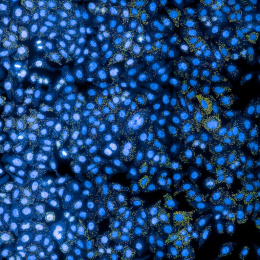Smart Nanoparticles Meet Ovarian Cancer Cells 5
Smart Nanoparticles Meet Ovarian Cancer Cells 5
Santiago Correa, Erik Dreaden
Koch Institute at MIT, MIT Department of Chemical Engineering
Effective treatments for cancer must minimize harmful side effects, like those that lead to nausea, pain, and hair loss during chemotherapy. Side effects are caused when potent chemotherapy drugs begin to build up in normal, healthy tissue where they cause unwanted damage. We minimize side effects by engineering “smart” drug delivery vehicles that preferentially bind to and accumulate in cancer cells. Here, we show a type of these “smart” drug-vehicles that sticks to and is taken up by ovarian cancer cells grown in the lab. We stained cancer cells with fluorescent dyes that help us identify their different parts – their membrane is colored purple, their nucleus is colored blue, and their lysosomes (tiny organelles that act as the cell’s “stomach”) are colored red. Our nanoparticles are showing up in green, and when the nanoparticles are taken up by the cells they often end up in their lysosome “stomachs”, where the combination of the red and green dyes shows up as yellow.
We took this image to test ten different types of layer-by-layer nanoparticles, our “smart” drug-delivery vehicles, for their ability to selectively and aggressively accumulate in ovarian cancer cells. We wanted to learn if by changing the outermost layer, we could help steer these nanoparticles to accumulate primarily in ovarian cancer. By learning which surfaces help our nanoparticles find and accumulate in cancerous tissue, we are improving the efficacy of our treatments (more drug is being delivered to the cancer) and reducing side effects (less drugs are ending up in healthy tissues).






